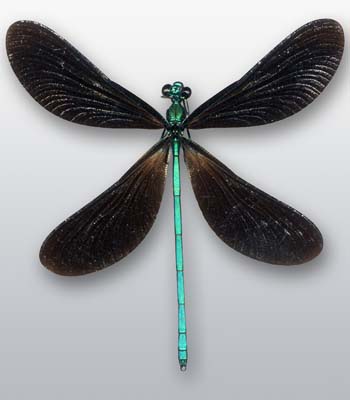
Adult blackwinged damselfly, Calopteryx maculata.
(Photographer: Seth Bybee, University of Florida)
Male and female damselflies differ in color, with the male usually more brightly colored. Damselflies have long, slender, colorful bodies and very long wings that narrow towards the base, forming a stalk. Unlike dragonflies, the wings are held over the body when at rest. Damselflies are usually smaller than dragonflies, but can be up to 5.0 cm long. The eyes are quite large and usually occupy most of the head region, which has short, bristle-like antennae.. Their long legs are used in capturing their prey and perching.
Like dragonflies, damselflies lay their eggs in or near water. Damselfly eggs can either be long and cylindrical, or broad and elliptical. It takes anywhere from one to three weeks for the naiads (nymphs) to hatch. The naiads are aquatic and breathe through gills which look like leaf-like appendages at the tips of the abdomen. Naiads range up to 2.5 cm in length, and have a modified lower jaw (labium) that they use to capture their prey. Damselfly naiads undergo between nine and 13 molts. They usually leave the water before they molt into the adult stage, which usually takes from 30 to 60 minutes.
Damselflies are found anywhere throughout the United States in various habitats.
Adult damselflies are ferocious hunters who feed on a multitude of insects. Damselfly naiads feed on various small aquatic organisms.
Images
To save the Web-optimized images shown below to your hard drive:
|
Click to access Display and Print quality images. |
|
Click to access Display and Print quality images. |